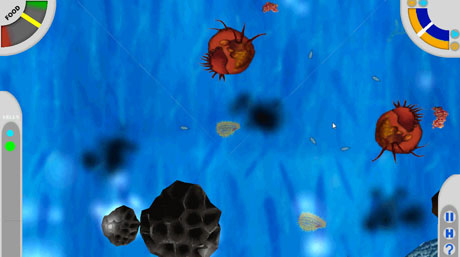Win or lose, this computer game teaches biology
By Bill Steele

As in many computer games, the goal of “Cellvival” is to survive in a hostile environment. Unlike most others, though, this game teaches some basic science. And unlike a lot of educational games, it’s fun to play.
You play as Tetrahymena thermophila, a single-celled organism that lives in fresh water, trying to catch food and avoid being eaten, and ultimately to reproduce and survive as a species. When you get enough food, you can reproduce, and when you reproduce you can adapt. The trick is to choose traits that will make you better equipped to survive. There are trade-offs: Speed makes your organism less maneuverable, and vice versa. Instead of levels, the game puts you in different environments, and the traits that make you best fitted to survive will be different in each one.
Ithaca-area high school students have been playing – and enjoying – the game, and whether they realize it or not, learning how evolution works, how the characteristics an organism inherits interact with its environment. “In order to play a game, you have to learn how to play the game, so kids are used to getting information from games,” explained Andrew Jefferson, a graduate student in the field of human development, who spearheaded development of the game. “One reason we went with evolution is that it involves abstract things that are hard to visualize. In a game you can take something abstract and make it concrete and play with it and experiment. Even if they die [lose the game], that’s still teaching them something about how it works.”
The project grew out of Jefferson’s conversations with Walker White, director of the Game Design Initiative at Cornell (GDIAC). Coincidentally, White had just been approached by members of the College of Veterinary Medicine’s ASSET (Advancing Secondary Science Education with Tetrahymena) program, who were interested in creating educational games to go with laboratory modules they provide to biology teachers. Jefferson works with Steven Ceci, the Helen L. Carr Professor of Human Development, and human development professor Wendy Williams, and has recruited a team of computer science students as programmers. He will describe the project at the Games, Learning and Society conference in Madison, Wisconsin, June 11-14. You can try out the game yourself at the GDIAC showcase, May 16 in Carpenter Hall.
After some polishing, the game will be distributed free to teachers through the ASSET program, along with lab modules that let students work in the classroom with the real Tetrahymena organism. Several teachers around New York state have already expressed interest, Jefferson said. The game is available in PC and Mac versions, with an accompanying lesson plan to guide classroom discussion.
The challenge, Jefferson said, is to satisfy both kids and teachers. “Educational games get a bad rap,” he noted. “Kids compare it with the games they paid for. Often in educational games you’re just answering quiz questions. … But if you don’t have those questions, teachers ask if kids are learning the game but not learning the content. It’s a balancing act.” But so far, he said, reception has been favorable. When he demos the game to adults the response is often, “That looks a lot better than I was expecting from an educational game.”
Testing will soon move to Ithaca middle schools, and Jefferson plans to create more games, in particular one that teaches critical thinking skills. The work so far has been funded by the National Institutes of Health.
Media Contact
Get Cornell news delivered right to your inbox.
Subscribe